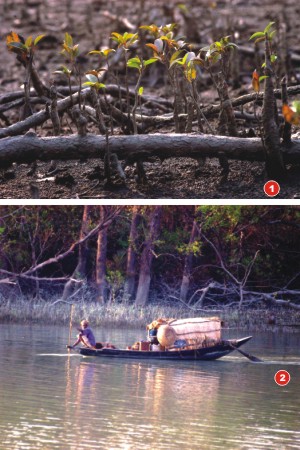|
Environment

 Home to 330 species of plants, over 270 species of birds, and 42 species of mammals including the majestic Royal Bengal Tiger and the spotted deer, the biggest mangrove forest in the world, the Sundarbans had to face one of the worst assaults from Mother Nature when a ferocious SIDR lashed out its wrath on the forests and all its remarkable inhabitants in November. While the devastation of flora and fauna was horrific, environmental and zoological experts have pointed out that it looks worse than it actually is. They say that forests like the Sundarbans have their own way of dealing with a natural disaster and tend to regenerate themselves, much like the human body trying to heal itself with its immune system. Home to 330 species of plants, over 270 species of birds, and 42 species of mammals including the majestic Royal Bengal Tiger and the spotted deer, the biggest mangrove forest in the world, the Sundarbans had to face one of the worst assaults from Mother Nature when a ferocious SIDR lashed out its wrath on the forests and all its remarkable inhabitants in November. While the devastation of flora and fauna was horrific, environmental and zoological experts have pointed out that it looks worse than it actually is. They say that forests like the Sundarbans have their own way of dealing with a natural disaster and tend to regenerate themselves, much like the human body trying to heal itself with its immune system.
As is evident from The Daily Star's photos by Syed Zakir Hossain, there are already signs of revival from newly sprouted leaves from the seemingly dead trees torn down by the cyclone to the ubiquitous kingfishers that decorate this spectacular forest and the thrill of finding pugmark trails. A recent media visit to the Sundarbans organised by Bengal Tours allowed photographers from the electronic and print media to see and capture for themselves the spectacular scenes that only a forest as grand as the Sundarbans can boast of and that continue to mesmerise visitors, despite the apparent ferocity of the recent cyclone.
Unfortunately the most crucial information, that the forest should be left alone to heal its own wounds, that it has an inbuilt mechanism to regenerate itself, was apparently not taken into account by the forest department, which was preparing itself to clear away all the debris of dead trees. Environmentalists have warned that this is the last thing that should be done. Moreover, they have said that new species of trees should not be planted in the forest either as it will interfere with the indigenous species.
Another bad spin off from the disaster has been the dramatic reduction of tourism because of exaggerated reports of the destruction in the forest. As the pictures prove, there is still wonderful sights to behold for the tourists. Unfortunately after the cyclone, the government has been thinking of keeping tourism to the Sundarbans on hold for one whole year so that the forest can be brought back to shape. But forest experts are unanimous in their appeal to open up and encourage tourism, as there is no reason for visitors to be dissuaded. Tourism provides employment and essential revenue to the area and to Bangladesh and a reduction in the number of tourists will spell a disaster much more debilitating than the cyclone ever was. Already an overwhelming number of bookings, mainly from Japanese and European tourist groups have been cancelled. Obviously these tourists must be informed of the good news: that the Sundarbans is back and kicking and ready to show off its breathtaking, wild beauty.


1. After taking a cruel beating from the cyclone, a forest rises from the debris as trees sprout new leaves from the broken branches. 2. For the local people the Sundarban is more than just a beautiful forest - it provides their means of survival. 3. The pretty Kingfisher is back. 4. A proud Heron surveys the surveys the scene. 5. The regal eagle spreads its wings. 6. An alert Shikra waits for its prey. 7. A saltwater crocodile takes a dip. 8. Finding pugmarks that lead into the forest - a thrilling bit of evidence of the Royal Bengal Tiger. 9. A serene dawn. 10. Regeneration. 11. Wild boars on a hunt for food. 12. Guarding the forest. 13. Grazing spotted deer make the stylised postcard picture of the Sundarbans.
|
Copyright (R) thedailystar.net 2008
|
